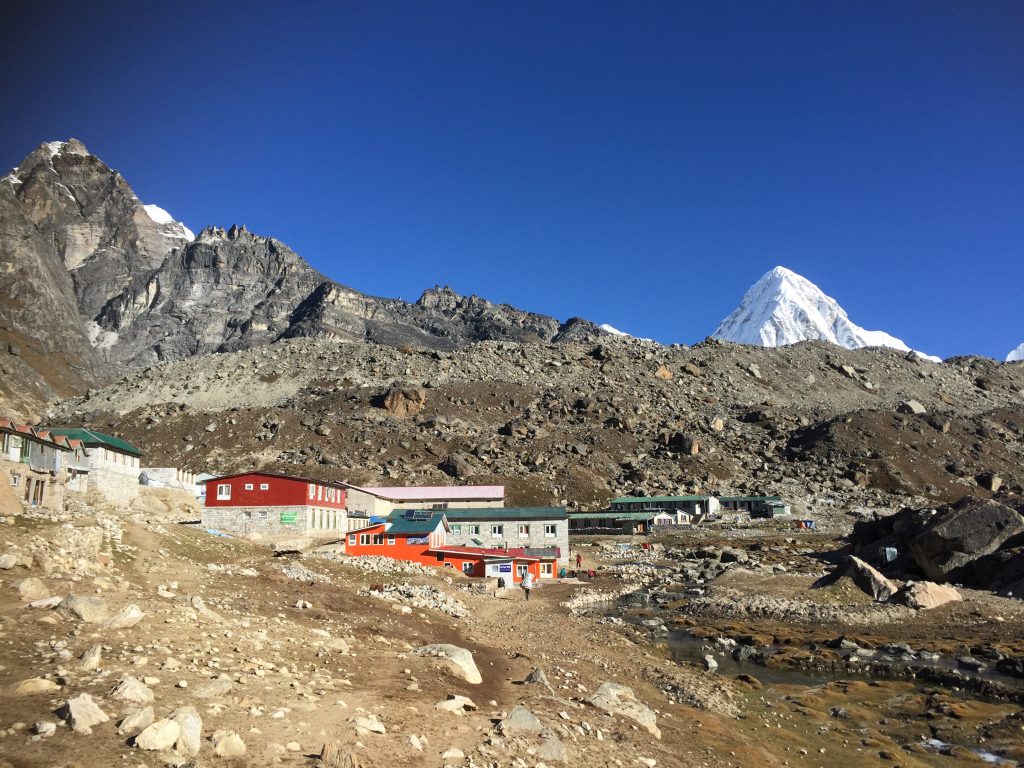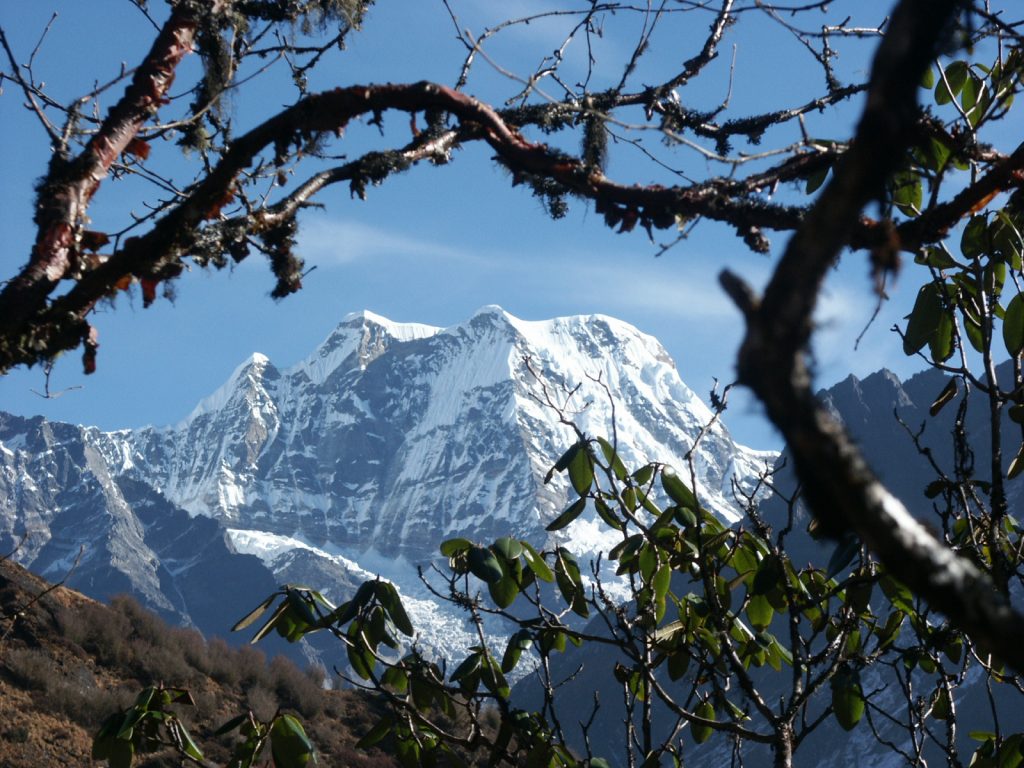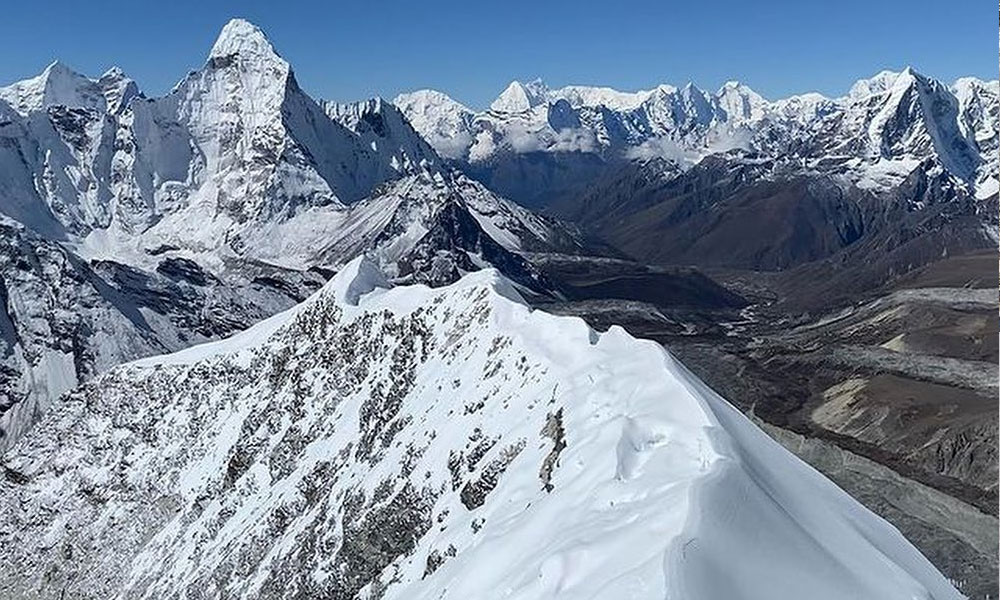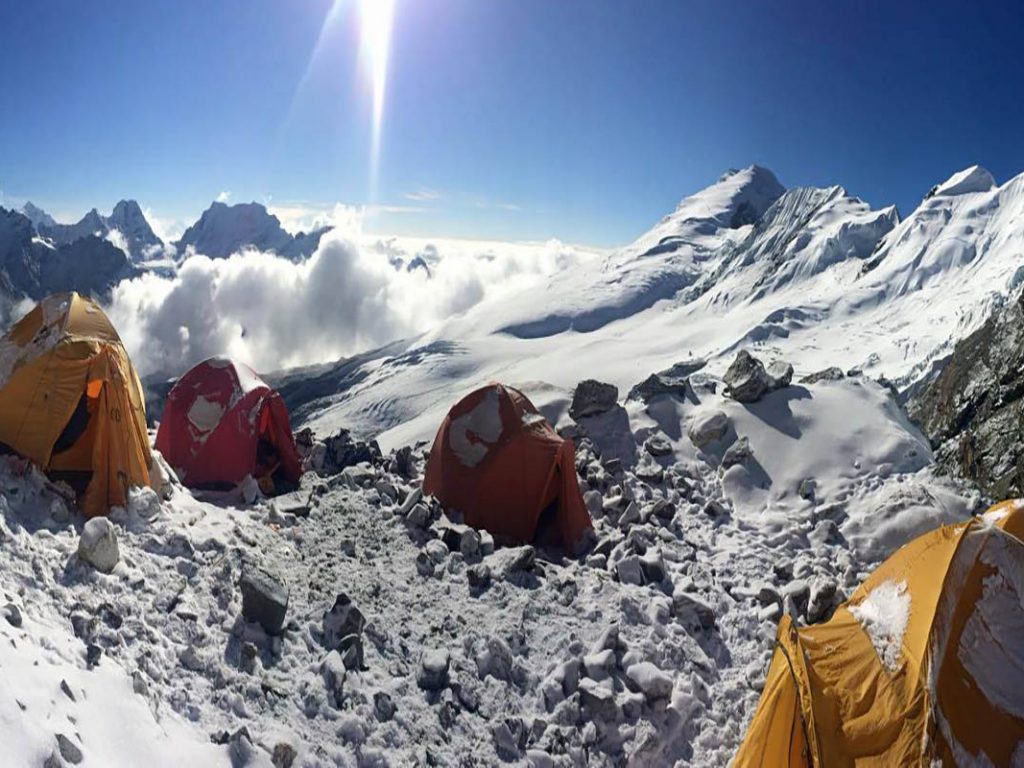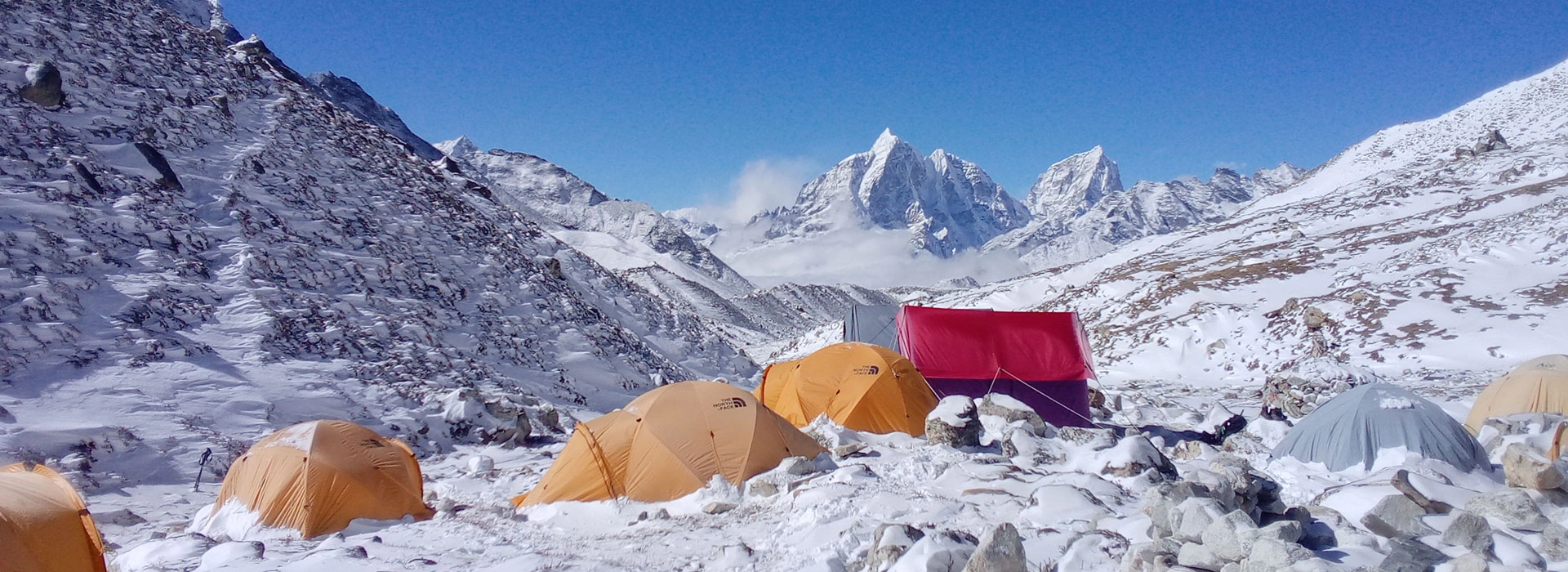
Mera, Island Peak & Lobuche Peak
with EBC Trekking
Mera, Island Peak & Lobuche Peak with EBC Trekking
Overview
Combining the Mera Peak, Island Peak, and Lobuche Peak climbs with the Everest Base Camp (EBC) trek is an ambitious and challenging adventure in the Everest region of Nepal. This itinerary allows you to experience three iconic climbing peaks while also trekking to the base camp of the world’s highest mountain.
Combining these three climbing peaks with the EBC trek is a demanding endeavor that requires proper physical fitness, previous mountaineering experience, and acclimatisation.
This combined itinerary typically takes around 29 days, including trekking, acclimatization, and climbing. It offers a unique opportunity to push your limits, experience high-altitude mountaineering, and witness the beauty of the Everest region in Nepal.
Day to day itinerary
Day 1: Arrival in Kathmandu (1400m/4592ft) – Transfer to hotel
Arrival and Welcome in Tribhuvan international airport, Kathmandu. Once you arrive in Kathmandu, our representative will meet you at the airport and drive you to your hotel. Check-in and take a rest. Overnight at a hotel in Kathmandu.
Day 2: Trip preparation in Kathmandu
You will meet your guide today and he will brief you on your upcoming climb. He will share some important tips and inform you about the condition of the route. There will be a final gear and equipment check after the briefing. As Ason, Kathmandu’s oldest market lie close to Thamel you can take a stroll down the bazaar and take photographs.Overnight at a hotel in Kathmandu.
Day 3: Fly to Lukla (2840m/9316ft) and trek to Paiya (2730m/8956ft) – 35 minutes flight and 5 to 6 hours trek
If you are lucky you will get a seat on the first flight to Lukla which flies directly from Kathmandu. If not, then you will be driven to Rammechhap Airport from where you board your plane. It is a thrilling experience to fly to Lukla, set amid high mountains and cliffs. Once you reach Lukla, you will meet the rest of the crew and head to Paiya. Take the trail to the south and head down to Surkey Village. From the village, the trail goes upwards to Chutok La. A short descent from the pass brings you to Paiya, a small settlement, and the first overnight stop.Overnight at a teahouse in Paiya.
Day 4: Trek to Panggom (2846m/9335ft) [6-7 hrs]
Walk past terraced fields, farms, and a lush forest. Cross the Paiya Khola, a small river, and climb up a mountain pass, Khari La. The trail follows an up and down route. Hike through thick rhododendron and bamboo forest and arrive at the picturesque Sherpa settlement of Panggom. Head to a teahouse and rest your tired legs.Overnight at a teahouse in Panggom.
Day 5: Trek to Ramailo Danda (3276m/10746ft) [5-6 hrs]
Leave Panggom and make your way towards Ramailo Danda. It is an upward ascent through a pristine rhododendron forest to Pankongma La (3174m), a mountain pass. We cross the Dudh Koshi River Valley and walk into the Hingku Valley. En route, we savor breathtaking views of Numbur Himal, Kongde, and Manju Peak. We stop briefly at Ningsow for lunch. Afterward, trek up and down to Ramailo Danda. From here we get our first view of Mera Peak. Overnight at a teahouse in Ramailo Danda.
Day 6: Trek to Chhatra Khola (2800m/9184ft) [6-7 hrs]
There are no human settlements or villages en route and the trail is wild and challenging. The park is home to Snow leopard, Red panda, Himalayan Tahr, musk deer, and many rare species of birds and plants. We stop at a quiet spot and have our packed lunch. Climbing stone staircases and walking past rocky paths we finally arrive at Chhatra Khola, our stop for the night. Overnight at a teahouse in Chhatra Khola.
Day 7: Trek to Kothe (3691m/12107ft) [6-7 hrs]
Taking the northward trail we walk past a thick bamboo forest and walk towards the Hinku Khola. We enter the Makalu Barun National Park and walk through a pristine trail. The park’s area stretches all the way to the Nepal-Tibet border. The Hinku Valley receives very few trekkers and chances are we may be the only group on the trail. A gradual up and down and after crossing a bridge before we finally arrive in Kothe. Overnight at a teahouse in Kothe.
Day 8: Trek to Thaknak (4358m/14295ft) [3-4 hrs]
After Kothe, we reach the Upper Hinku valley where the treeline disappears. There are no villages en route only ‘kharkas’ the summer camps of yak herders dot the landscape. Walk past Gondishung and Lungsumgba Gompa, a two-centuries-old Buddhist shrine. Lying underneath an enormous boulder, the local crew pay homage to deities burning incense.
En-route enjoy amazing views of Charpati Himal, Mera Peak, Kusum Kanguru, and Thamserku. After walking for about an hour we reach Thaknak, a summer camp of yak herders. Charpati Himal lies close to the teahouse and we can see the whole mountain.Overnight at a teahouse in Thaknak.
Day 9: Trek to Khare (5045m/16548ft) [3-4 hrs]
Today’s walk involves an ascent to the Dig Glacier and the Charpati Tal, a mountain lake. With stunning views of the Kyeshar glacier, Mera Peak, and Charpati Himal we walk down to Dig Kharka. A tough crossing of the Hinku Nup and Shar glaciers brings us to Khare. Khare lies at the bottom of Mera Peak and is also known as Mera Peak Base Camp. We climb Mera Peak from here.Overnight at a teahouse in Khare.
Day 10: Acclimatization Day in Khare and pre-climb training
Today you will spend your time acclimatizing and practicing your climbing moves at the pre-climb training camp. Our Sherpa climbing guides will teach you how to properly use climbing equipment like jumar, carabiner, belay device, ice axe, harness, etc. They will teach you the basic and safe techniques to scale an incline using a rope and harness.
This training is valuable and helpful if you are a novice climber. A final gear and equipment check will be followed by final packing for the summit push. Please keep in mind climbing boots of size 12 and greater are not readily available in Nepal. If your shoe size is 12 or 12 plus you need to bring it with you from your home country. Overnight at a teahouse in Khare.
Day 11: Trek to Mera High Camp (5780m/18958ft) [5-6 hrs]
Take the steep and rocky path to Mera La. The three summits of Mera Peak – Mera North (6476m), Mera Central (6461m), and Mera South (6065m) – gleam invitingly. We will be climbing the summit of Mera Central. Crossing the Mera glacier we reach Mera Peak high camp. It is an easy hike up a slope with no technical climbing involved.
On reaching Mera High Camp, the crew serves us hot drinks. Enjoy views of five of the fourteen highest peaks in the world- Mount Everest (8848m), Lhotse (8516m), Makalu (8485m), Cho Oyu (8188m), and Kanchenjunga (8586m). Chamlang (7319m), Gaurishanker (7134m), and Baruntse (7129m) also appear close. A single sleeping tent will be given to each climber. Food will be prepared by the local crew in a kitchen tent. Overnight at a tented camp in Mera High Camp.
Day 12: Summit Mera Peak (6461m/21193ft) and trek to Kongma Dingma (4850m/ 15908ft) – 11 to 12 hours trek/climbing
At 2 AM we prepare for the final summit push. After breakfast, we head out and rope up. A man-rope will secure our group. Hike up the glacier in a single file. No technical climbing is required in this section. The thin air and cold are the only factors that make the ascent difficult. Above 5000 meters we struggle to breathe properly and taking a step forward takes a lot of effort.
The last 40-50 meters to the summit is the most challenging portion. It is a steep incline and fixed rope and jumars are used to climb to the summit. By 9 or 10 AM we reach the summit. Amazing views of Mount Everest (8848m), Makalu (8481m), Kanchenjunga (8586m), Cho Oyu (8201m), Lhotse(8516m), and other peaks surround us.
After spending 5 or 10 minutes savoring the victory and taking pictures we head down via the same route. We reach Mera High Camp have some refreshments. Later we hike down to make a quick descent to Khare. From Khare, we head east. Taking a downward trail we reach Kongma Dingma where we rest for the night. Overnight at a tented camp in Kongma Dingma.
Day 13: Contingency Day for the summit
A buffer day in case our summit bid gets canceled due to bad weather or ill health. This extra day will also come in handy if our domestic flight gets delayed or any unforeseen emergency. If everything goes as planned, you can use this day to explore some more places on the trail or in Kathmandu.
Day 14: Trek to Seto Pokhari (5035m/16520ft) [5-6 hrs]
Leaving Kongma Dingma we walk past yak pastures and summer camps of yak herders. We proceed towards Seto Pokhari enjoying captivating views of Baruntse and Chamlang Himal. Overnight at a tented camp in Seto Pokhari.
Day 15: Trek to Amphu Lapcha Base Camp South (5650m/18532ft) [5-6 hrs]
Climbing up a snowy moraine we reach the beautiful Seto Pokhari, a glacial lake. Head to Amphu Lapcha Base Camp enjoying views of Mount Everest and lakes along the Hongu basin. A walk past the Hongu Pokhari above the Hongu valley brings us finally to the Amphu Lapcha Base Camp. Overnight at a tented Camp in Amphu Lapcha Base Camp.
Day 16: Cross Amphu Lapcha (5845m/19172ft) and trek to Island Peak Base Camp (5100m/16728ft) [9-10 hrs]
After leaving the base camp you make your way across a snowy trail to Amphu Lapcha Pass. You are in the dramatic Upper Hongu Valley which is one of the wildest areas in the Everest Region. Cold, Harsh, and challenging, no human settlements are found at this place.
After walking for about 4 to 5 hours you arrive at the pass. The pass looks stunning but daunting. Covered with ice shelves and serac cliffs, it is a steep incline and you use fixed rope, jumar, and ice axe to ascend the pass. This is one of the most difficult sections of your trip. The top is a narrow ridge filled with rocks. You get down using a fixed rope again. A walk through the Imja Glacier brings you to the Imja Tsho Lake in the Imja Valley. From here climb up a rocky moraine and head to Island peak Base Camp. Overnight at a tented camp in Island Peak Base Camp.
Day 17: Rest day at Island Peak Base Camp (5100m/16728ft)
The crossing of the Amphu Lapcha pass is grueling and leaves you exhausted. Rest and get your energy back. There will be checking of gear and equipment before the summit push. Have an early night for the big day tomorrow. Overnight at a tented camp in Base Camp.
Day 18: Summit Island Peak (6189m/20305ft) and trek to Chukkung (4730m/15519ft) – 11 to 12 hours trek/ climbing
After breakfast, we carry your pack and head out at 1 AM. Our daypack consists of snacks, camera, packed lunch, water, and any memento we want to leave at the summit.
After ascending a rocky path you reach High Camp. Continue on a slope for about 3 hours to reach Crampon Point, the place where we put on our crampons as the trail becomes icy and snowy. We move ahead on a frozen trail in a group. From 5700m onwards the group will be secured by a man-rope. Walking on a narrow ridge brings us to the base of Imja Glacier. The sunrise over the Makalu, Ama Dablam, Baruntse, and Chamlang look stunning. As the slope is at an angle of 45 to 50 degrees the ascent is not that technical. The guides fix the ropes at the glacier.
As we near the summit Lhotse appears very close. Lhotse hides the summit of Everest, so Mount Everest is not visible from Island Peak. The climb up a vertical wall using fixed rope before reaching the summit is the toughest part. We ascend the anchor points and cross crevasses using ladders.
Holding on to the fixed rope and we walk along the ridgeline to the summit. The views are amazing. We have done it! At the summit, we take pictures and return via the same route. The descent is long and exhausting. We need to be extra careful as most of the accidents at Island Peak happen during descents. On reaching Base Camp we take rest and celebrate our victory. Later in the day, we hike down to Chukkung. Overnight at a teahouse in Chukkung.
Day 19: Contingency Day for the summit
A buffer day in case our summit bid gets canceled due to bad weather or ill health. This extra day will also come in handy if our domestic flight gets delayed or any unforeseen emergency. If everything goes as planned, you can use this day to explore some more places on the trail or in Kathmandu.
Day 20: Trek to Lobuche (4910m/16109ft) via Kongma La Pass (5535m/18159ft) [7-8 hrs]
Wake up early and take the westward trail out of Chukkung. Cross a stream and follow the Kongma La route.
Lying beyond the busier EBC route, the trail is isolated and you can find yourself connecting with nature. Walk along the Imja Valley and cross the Imja Khola(river). Take a steep ascent and walk along grassy yak pastures. You come across a frozen lake and some waterfalls.
Follow the well-defined path up the mountainside for the first view of Kongma La. You hike across rock and scree to reach the top of the Kongma La Pass. From the top, you can enjoy panoramic views of Mount Everest, Gauri Shanker, Pumori, Makalu, and the frozen 8-mile long wall of Nuptse and Lhotse.
After taking in the views head down. It is a steep descent over boulders and loose rocks. Mind your step and walk carefully. You are walking on the Khumbu glacier and there are crevasses you should be careful of. You can actually hear the glacier moving, the ice shifting below. The stark and bare landscape has a beauty of its own, and you can’t help taking pictures, however, tired you may feel.
After a long hard day of your first mountain pass traverse, you finally reach Lobuche. Have your dinner and take a much-needed rest at the teahouse. Overnight in Lobuche.
Day 21: Lobuche to Lobuche High Camp (5400m/17716ft) [3-4 hrs]
Wake up and have breakfast. From Lobuche you head up to High Camp. You make your way up the village to the mountain. It is a steep climb and involves a traverse through the Lobuche Glacier and a rocky moraine. In a little over two hours you reach High Camp. Once you reach High Camp you will find the tents pitched up. Have lunch prepared by the crew and prepare for the pre-climb training. After lunch a rope course will be set up on a slope leading to the mountain. This training will offer the climbers the basic experience they will need on their Lobuche peak climb. From basics like how to put on your harnesses, helmet, crampons to the more complicated lessons on how to use ascenders, descenders, ice axes and cross anchors. Your climbing guide will demonstrate how to traverse the rope and rappel down the rope. Lastly you get to practice going up and down the rope using your harness and jumars. You can practice it twice or thrice until you feel comfortable using the harness and ascending and descending on the rope. Have an early night as you have a long day tomorrow. Overnight in High Camp.
Day 22: Summit Day – Lobuche High Camp to Lobuche East Summit (6119m/20075ft.) –Trek to Lobuche 4900m/16076ft) [9-10 hrs]
You make the summit push today. Wake up around 1 AM or earlier and have breakfast. By 2 am we start our climb to the summit of Lobuche East. It is a steep ascent past a rocky trail. After walking for nearly 2-3 hours we reached Crampon point. This is where we put on our crampons. We will be walking along the Lobuche glacier on snow and ice. At steep portions ropes will be fixed and we ascend these portions using ascenders. Though there are no crevasses or ladders along the way, climbing Lobuche Peak is much more technical and challenging than Island Peak. From high camp we climb up to the summit in about 5-6 hours. From the summit enjoy close up views of Mount Everest, Lhotse, Makalu, Cho Oyu, Barun Tse, Ama Dablam, Chamlang, Thamserku, Gaurishanker and Dudh Kunda area.
The whole valley looks incredible from the top. Savour this incredible moment and take pictures. Later make your way down to High Camp. At sections where the ropes have been fixed you need to rappel down. Our crew will be waiting for you at the High Camp with hot soup and drinks to warm you up. Have your lunch and after a bit of rest descend down to lobuche.
Day 23: Contingency Day for summit
An extra day reserved for summit bid if you are not able to reach the summit previous day due to bad weather or ill health. This day can also be used for unforeseen delays and hurdles during the trip. Bad weather may contribute to flight delay or cancellation of plans. There may also be other unforeseen emergencies which may upset your plans. Therefore, having a spare day would serve as a back-up for any unexpected delays. If your trip goes as planned, then you can use this day to rest and explore a village en route on the trail. You can take it slow and walk at an easy pace on your return trek. Or you can use this extra day for sightseeing in Kathmandu.
Day 24: Trek to Gorak Shep (5140m/16864ft) – Hike Everest Base Camp (5364m/17598ft) [7-8 hrs]
Today you hike to Everest Base Camp, one of the milestones of your trek. Though the trail is not that difficult, the walk is not easy. High altitude makes it difficult to take each step. Take deep breaths and keep your breathing and pace steady. Don’t walk too fast. It’s better to maintain a slow rhythm. Drink lots of water and keep yourself hydrated.
You stop at Gorak Shep, have refreshments and some rest. You leave your stuff at the teahouse and continue your hike to EBC. Walk along the amazing Khumbu Glacier. The landscape devoid of greenery and filled with frozen icicles, snow, dirt and pebbles, and rocks feel out of this world. It feels as though you are in the midst of a sci-fi movie
Your arrival at Everest base Camp fills you with exhilaration. You have reached one of the highest hiking destinations on Earth. Celebrate with your teammates and take pictures. You can see the massive wall of the Lhotse, Western Cwm, Nuptse and the Khumbu Icefall.
The summit of Mount Everest is too high to be seen from the base camp. On the far side, there’s a rocky valley where camps of Everest summiteers are set up (if it’s climbing season). Soak in the sights and take more pictures before heading down to Gorak Shep.
The day had been tiring and it’s great to snuggle in the warm comfort of your bed. Have an early night because you have another eventful day tomorrow. Overnight in Gorak Shep.
Day 25: Hike to Kalapatthar, trek down to Pheriche (5555m/18225ft – 4358m/14297ft) [7-8 hrs]
After a good night’s rest in Gorak Shep, those who feel ready and able, will wake up very early and hike up Kala Phattar to see the sun rise over Everest. This is a difficult 3 hour up-hill hike which is very hard work, but well worth it for the amazing views of Everest in the early morning. Once you return back to Gorak Shep, you will have breakfast and return all the way to Pheriche at 4358m/14297ft. which can take 4 hours, making the total amount of time walking 7 hours today.
Day 26: Trek down to Namche Bazaar (3440m/11286ft) [7-8 hrs]
Today we will trek from Pheriche back to Namche Bazaar. Today is another long day and can take approximately 7 to 9 hours. As you are heading downhill, to lower levels of altitude and you can cover the ground quicker than on the way up. When you get back to Namche you will get to enjoy the delights at the Namche Bakery or play a few rounds of pool at Cafe Danfe before we rest up for the long walk back to Lukla tomorrow.
Day 27: Trek down to Lukla (2652m/8700ft) [7-8 hrs]
This long day can be one of the hardest as your body is tired after the trek. You start the day going back down Namche Hill and then the long stretch back to Lukla. You will pass Phakding before starting the last uphill section into Lukla where we will sleep for one more night. Today’s trek can take 7 to 8 hours.
Day 28: Fly back to Kathmandu (1300m/4265ft). 35 minutes flight
Today your legs get a break as you only have to trek to Lukla Airport and fly back to Kathmandu, which is only about 10 minutes walking.
Today, we will go to one of Nepal’s authentic restaurants & will have Nepali dinner with some traditional Nepali songs and dances. Overnight at Kathmandu Hotel.
Day 29: Departure to the Airport
Today, we will send you to the Airport approximately 3 hours before your scheduled flight.



